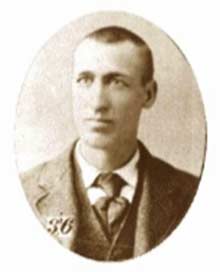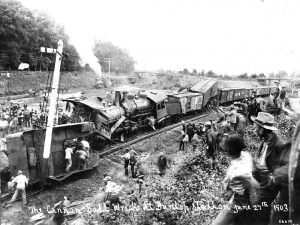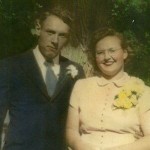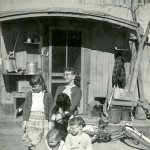caboose
 Jonathan Luther “John” “Casey” Jones was born on March 14, 1863. As a boy, he lived near Cayce, Kentucky, which is where his nickname of “Cayce” came from, but he chose to spell it “Casey”. Jones went to work for the Mobile & Ohio Railroad and performed well and was promoted to brakeman on the Columbus, Kentucky to Jackson, Tennessee route, and then to fireman on the Jackson, Tennessee to Mobile, Alabama route. That caught my attention, because my grandfathers and other family members worked for the railroad too, but it was not working on the railroad that made Casey famous…at least not totally anyway. Casey always dreamed of being an engineer. He worked hard, but did receive nine citations for rule violations, and 145 total days suspended. In the year prior to his death, Jones had not been cited for any rules infractions. His dreams came true, but not in the way he expected. In the summer 1887, a yellow fever epidemic struck many train crews on the neighboring Illinois Central Railroad, providing an unexpected opportunity for faster promotion of firemen on that line. On March 1, 1888, Jones switched to the Illinois Central Railroad, taking a freight locomotive between Jackson, Tennessee and Water Valley, Mississippi.
Jonathan Luther “John” “Casey” Jones was born on March 14, 1863. As a boy, he lived near Cayce, Kentucky, which is where his nickname of “Cayce” came from, but he chose to spell it “Casey”. Jones went to work for the Mobile & Ohio Railroad and performed well and was promoted to brakeman on the Columbus, Kentucky to Jackson, Tennessee route, and then to fireman on the Jackson, Tennessee to Mobile, Alabama route. That caught my attention, because my grandfathers and other family members worked for the railroad too, but it was not working on the railroad that made Casey famous…at least not totally anyway. Casey always dreamed of being an engineer. He worked hard, but did receive nine citations for rule violations, and 145 total days suspended. In the year prior to his death, Jones had not been cited for any rules infractions. His dreams came true, but not in the way he expected. In the summer 1887, a yellow fever epidemic struck many train crews on the neighboring Illinois Central Railroad, providing an unexpected opportunity for faster promotion of firemen on that line. On March 1, 1888, Jones switched to the Illinois Central Railroad, taking a freight locomotive between Jackson, Tennessee and Water Valley, Mississippi.
Jones was a bit of a risk taker, but I doubt if some of the people who knew about some of his “risks” would hold that against him. A little-known example of Jones’ heroic act saved the life of a little girl. As Jones’ train approached Michigan City, Mississippi, he had walked out on the running board to oil the relief valves. He had finished well before they arrived at the station, as planned, and was returning to the cab when he noticed a group of small children dart in front of the train some 60 yards ahead. They all cleared the rails easily except for a little girl who suddenly froze in fear at the sight of the oncoming iron horse. Jones shouted to Stevenson to reverse the train and yelled to the girl to get off the tracks in almost the same breath. Then he realize that she was frozen in fear. He raced to the tip of the cowcatcher and braced himself on it, reaching out as far as he could to pull the frightened but unharmed girl from the rails.
On April 30, 1900, while Casey was running the Cannonball Express, and trying to make up for a late start, it would be his heroics that would cost him his life. As Casey was coming into Vaughan, Mississippi, he did not know that three separate trains were in the station at Vaughan…double-header freight train No. 83 and long freight train No. 72 were both in the passing track to the east of the main line. As the combined length of the trains was ten cars longer than the length of the east passing track, some of the cars were stopped on the main line. The two sections of northbound local passenger train No. 26 had arrived from Canton earlier, and required a “saw by” for them to get to the “house track” west of the main line. The “saw by” maneuver required that No. 83 back up (onto the main line) to allow No. 72 to move northward and pull its overlapping cars off the main line and onto the east side track from the south switch, thus allowing the two sections of No. 26 to gain access to the west house track. The “saw by”, however, left the rear cars of No. 83 overlapping above the north switch and on the main line…right in Jones’ path. As workers prepared a second “saw by” to let Jones pass, an air hose broke on No. 72, locking its brakes and leaving the last four cars of No. 83 on the main line.
Jones was almost back on schedule, running at about 75 miles per hour toward Vaughan, and traveling through a 1.5 mile left-hand curve that blocked his view. Webb’s view from the left side of the train was better, and he was first to see the red lights of the caboose on the main line. “Oh my Lord, there’s something on the main line!” he yelled to Jones. Jones quickly yelled back “Jump Sim, jump!” to Webb, who crouched down and jumped from the train, about 300 feet before impact, and knocked unconscious by his fall. The last thing Webb heard as he jumped was the long, piercing scream of the whistle as Jones warned anyone still in the freight train looming ahead. He was only two minutes behind schedule. Jones reversed the throttle and slammed the airbrakes into  emergency stop, but “Ole 382” quickly plowed through a wooden caboose, a car load of hay, another of corn, and halfway through a car of timber before leaving the track. He had reduced his speed from about 75 miles per hour to about 35 miles per hour when he hit. Because Jones stayed on board to slow the train, he saved the passengers from serious injury and death. He was the only fatality of the collision. His watch stopped at the time of impact…3:52 am on April 30, 1900. Legend holds that when his body was pulled from the wreckage, his hands still clutched the whistle cord and brake. A stretcher was brought from the baggage car on No. 1, and crewmen of the other trains carried his body to the depot, a half-mile away.
emergency stop, but “Ole 382” quickly plowed through a wooden caboose, a car load of hay, another of corn, and halfway through a car of timber before leaving the track. He had reduced his speed from about 75 miles per hour to about 35 miles per hour when he hit. Because Jones stayed on board to slow the train, he saved the passengers from serious injury and death. He was the only fatality of the collision. His watch stopped at the time of impact…3:52 am on April 30, 1900. Legend holds that when his body was pulled from the wreckage, his hands still clutched the whistle cord and brake. A stretcher was brought from the baggage car on No. 1, and crewmen of the other trains carried his body to the depot, a half-mile away.
 In mid 1951, my father-in-law was hired to work on the railroad in Dalin, Montana. It was a necessary job change for him, since the prior job he had been working couldn’t seem to pay it’s employees, and you just can’t raise a family with no money, nor can you continue to work for someone on the hope that they will finally pay you. I’m quite certain that this job felt like they were rich, after the struggles of the previous situation.
In mid 1951, my father-in-law was hired to work on the railroad in Dalin, Montana. It was a necessary job change for him, since the prior job he had been working couldn’t seem to pay it’s employees, and you just can’t raise a family with no money, nor can you continue to work for someone on the hope that they will finally pay you. I’m quite certain that this job felt like they were rich, after the struggles of the previous situation.
At the time of the move to Dalin, they had only their daughter, Marlyce. During their 5 years in Dalin, the family would grow by two more children. Debbie was born in 1953, and my future husband, Bob was born in 1954. Both Debbie and Bob were born in Miles City, Montana, although Bob was almost born on the road between Billings, where the family had gone to spend the day, and Miles City. Thankfully they made it in time, and Bob was born in the hospital in Miles City.
During the years they lived there, the family lived in a house that was owned by the railroad. There were actually two houses on the property. A big house where the boss lived, and a smaller house where my future in-laws lived. But the interesting thing about the property was that there were also two railroad cabooses that had been turned into homes for some of the other railroad employees.
Now, I don’t know about you, but to me, that would be an interesting idea. I’m sure someone decided that it would be an inexpensive way to house the employees who didn’t have big families, and it did serve it purpose, as you can see in the picture. The kids must have thought it was interesting, because they liked to play around there, although maybe they never gave it much thought. When I look at it from the future, it seems like a very  different kind of life than any I would have imagined, but I suppose that many things we take for granted today would seem quite strange to the people of the past.
different kind of life than any I would have imagined, but I suppose that many things we take for granted today would seem quite strange to the people of the past.
Trains have always held an interest for me, and I especially liked the caboose, so I’m quite sure I would have wanted to see what they were like inside, and maybe the kids did get a chance to see for themselves, I don’t know for sure. I also think I might have found it somewhat interesting to live in a caboose, at least in the short term. It would undoubtedly get to be pretty cramped after a while, but for the single person workin’ on the railroad, it might have been just the ticket.

